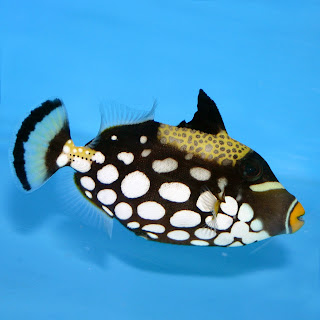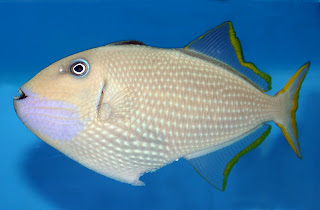Welcome back Mellisa, I hope that you enjoy this general article about Triggerfish. These are facinating, beautiful, and fun fish to keep in your marine aquarium.
Triggers are with out a doubt some of the most aggressive saltwater fish available to hobbiest. They are carnivores and will eat any small tank-mates. Triggers usually aren’t very picky when it comes to food. They should be fed shrimp, scallops, krill as well as meaty pellets. Triggers should be housed in a large tank 100 gal or more. Larger wrasses, groupers, eels, and large angels are acceptable tank-mates. Most triggers are not reef safe and will chomp on corals, eat crustaceans, as well redecorate the tank upsetting corals and live rock. Use extreme care when placing heaters and power head cords inside the tank. Triggers tend to be very curious and may nibble on the cord causing harm to themselves as well as other tank mates. An aquarist must use caution when working in the tank to avoid being bitten.

In the store we sell several different species of triggers. Some are very aggressive and should be kept alone while others are fairly docile and may be kept in a reef tank with caution.
One of my favorite triggers is the Queen trigger (Balistes vetula). What can I say, I love my queens (Queen angels and Queen triggers). Queen triggers are gorgeous but don’t let their attractiveness fool you. They are very aggressive and get very large which may be part of the reason this fish is not seen all that often in the trade.
The Fuscus trigger (Pseudobalistes fusco), Clown trigger (Balistoides conspicillum), and Undulated trigger (Balistoides undulatus) are also very aggressive triggers but are commonly seen in the trade. These triggers are very attractive and will add character to any predatory tank, just make sure other tank-mates are established and will be tough enough to hold their own.
 There are a few triggers that are considered “reef safe” with caution since they are mainly planktivorous. While these “reef safe” triggers do not eat coral, they will most likely eat hermit crabs and shrimp, so be prepared for this behavior if you try them in your reef.
There are a few triggers that are considered “reef safe” with caution since they are mainly planktivorous. While these “reef safe” triggers do not eat coral, they will most likely eat hermit crabs and shrimp, so be prepared for this behavior if you try them in your reef.
Some triggers in this category include Blue Jaw triggers (Xanthichthys auromarginatus), Sargassum triggers (Xanthichthys ringens), Pink Tail triggers (Melichthys vidula) and Niger triggers. These triggers appear to be less aggressive and are commonly seen in the trade.
I hope that you enjoyed Mellisa’s article. Until next blog,
Dave
 That Fish Blog – Aquarium Advice and Information
That Fish Blog – Aquarium Advice and Information



I always thought triggers were cool! they almost seem to smile.
I have a HumuHumu that I love, but he’s a pain in the neck. I can’t keep snails and crabs in the tank – he took out 10 huge turbo snails that had gorgeous corraline algae growing on them. Any advice?
Dan,
Unfortunately, crustaceans (shrimp, crabs, starfish, SNAILS, urchins, etc.)are a staple of the triggerfishes diet in the wild, they are naturally attracted to these animals as a food source. If you are keeping your HumaHuma Trigger well fed on other item, and it is still picking on your snails, then there is most likely little that you can do to prevent this from continuing to happen. Sorry I do not have a real solution to offer, I think that your best option is to decide which you want to keep more and exclude the other.
Thanks,
Dave
I love the article on triggers, they are without a doubt my favorite fish. I curently have a humu trigger with a lunar wrasse and they do fine together. I also have a fairly large dark purple hammer coral, a frogspawn, chalice, and a green polyp leather coral. My LFS has a 2 inch undulated trigger that i am very interested in trading my humu for but i have read a thousand different articles saying that these fish would eat coral and then others that say they wont, any input would be greatly appreciated because i love the undulated! My humu doesnt mess with my corals but if i could keep the undulated by himself and keep the corals that would be awesome, i have no problem letting the wrasse go if need be.
Thanks,
Ryan
Hi Ryan. I’ve never heard of an Undulated Trigger eating corals, but they do tend to be very aggressive and belligerent and I wouldn’t put it past one to bite a coral out of spite :). Each fish has an individual personality, and I don’t think your corals will be in any real danger, but any other fish and inverts will likely not last long with him once established.
i would like to clear some things up i have two trigger fish a huma huma and a niger trigger and they do well in an 80 gallon tank they school well with green chromis that are allot smaller than they are and you are saying these fish eat they’re tank mates i would just like to say this blog is very misleading about the trigger fish and the only true thing i read was that they will eat crabs so please read your facts next time about trigger fish before you mislead them
Hello Liam, Thanks for your comments. This blog is a simple overview of a large group of fish and different species of trigger will certainly have different behaviors. Some may be safe with more peaceful tankmates while others will attack anything that looks like prey, including other fish and inverts. I’m surprised to hear that your Huma Huma Trigger especially is tolerating small tankmates like Green Chromis and I certainly hope it stays friendly for you!
How do you think a picasso trigger fish and a pistol shrimp w/gobie would get along? If I had a cleanup crew that was all turbo snails and hermit crabs would the picasso trigger eat that? Thanks.
Hello Gary, Triggers will eat crustaceans and other inverts, especially the more aggressive triggers like Picasso’s. It is possible that it might leave them alone if it is well-fed, but all of the Rhinecanthus triggers are some of the most temperamental and its possible they may bite at them just out of curiosity alone at some point. They may also attack small fish like gobies so it is hard to say or predict how successful that combination may be. Triggers are best kept in a larger semi-aggressive community.